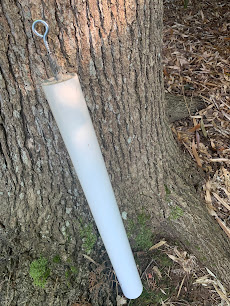Tuesday, September 15, 2020
The Sun is Back!
Tuesday, September 8, 2020
Replacing the Telrex Tri-Bander
About three years ago, I noticed a stuttering of the heading needle of my Tailtwister rotor control box as I turned the yagis on my tower, and I initially figured it was just dirty contacts on the pot in the rotor. Nope. I wish it was that simple.
The tower is a 100 feet of phillystran-guyed Rohn 45G with a pair of multiband yagis on top. The lower antenna is a Telrex 10/15/20 meter tribander (circa early 90's) on a 26' boom, and the upper antenna is a Force12 12/17/20 meter yagi.
When they were installed in about 2000, the tops of the oak and poplar trees were about 7 to 10' lower than the lowest antenna. They grew enough over the years to just catch the longest elements on the Telrex.... This damaged the elements, and the resulting bends created a weak spot that eventually doomed several pieces of tubing. The antenna persisted for many months after being damaged, but eventually succumbed to the wind vibration and resulting metal fatigue where the elements had been bent.
Is it dicey having a guyed tower in a wooded location? Yes....but it was a risk I was willing to take given the alternatives in my situation. My main concern over the years has been a tree falling on a guy wire, which would likely bring the tower down -- so I've had to be vigilant in removing any trees that look like they might fall in the wrong direction. What I didn't do is keep a close eye on what was happening up top!
This TB6EM was the best made Yagi for HF that I've used...and it'll be missed. The enormous diameter double walled boom utilized through-the-boom elements. It was beautiful and she performed extremely well for decades, despite being a trapped design -- which we know today is lossy, compared to other multi-monobander approaches. I'm in the middle of tree pruning now and making plans for taking down what remains of the Telrex, and then, I'll be selecting a new 21st century model to replace it. This is a lot of work, but it'll be worth it.
Update 4/14/2021:
This winter I was able to clear back a number of trees that were interfering with my turning radius of the yagi, and made sure I have a 30' wide path from the ground up to the top of the tower. I've fabricated a trolley from aluminum (will have a separate post on this) which will run from the ground to the top on two cables. This will be used to remove the TB6EM and replace. After looking at many, many designs -- I'm leaning towards the OptiBeam Log Yagi design.
Thursday, June 25, 2020
Weights for Tree Supported Wire Antennas
 |
| PVC-Concrete Antenna Weight |
 |
| Standard Wire Antenna Approach |
 |
| 2" PVC, Rebar, Lag Eye Bolt |

